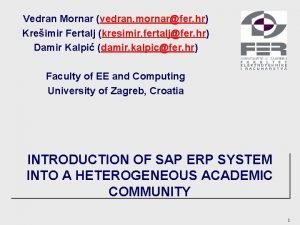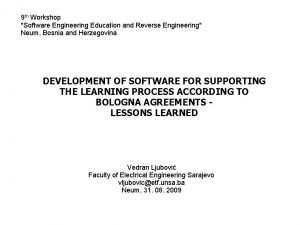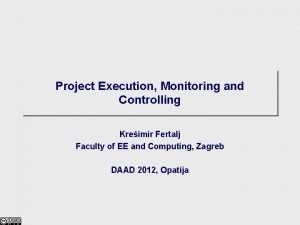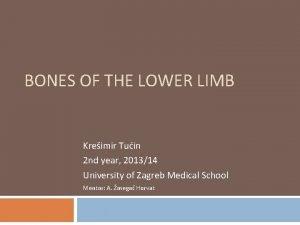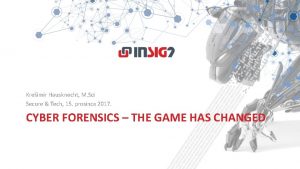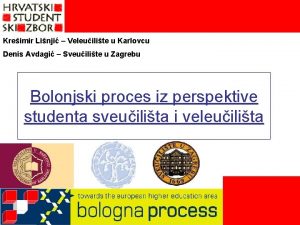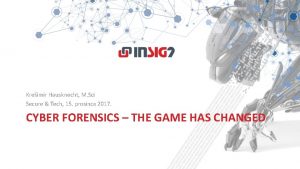Vedran Mornar vedran mornarfer hr Kreimir Fertalj kresimir




















- Slides: 20

Vedran Mornar (vedran. mornar@fer. hr) Krešimir Fertalj (kresimir. fertalj@fer. hr) Damir Kalpić (damir. kalpic@fer. hr) Faculty of EE and Computing University of Zagreb, Croatia INTRODUCTION OF SAP ERP SYSTEM INTO A HETEROGENEOUS ACADEMIC COMMUNITY 1

Introduction q A case study of introduction of a complex ERP system into a complex and heterogeneous environment n the context n the major steps of ERP implementation to the authors’ institution n current status and foreseeable further developments q The aim – expand the system to the other University members n difficulties and risks encountered

The history q The authors’ home institution has a remarkable history in efforts to computerize its core activities n student administration, subsidized students’ nourishment, scheduling of lectures, the library and support to educational activities q Administration and bookkeeping were regarded as standard tasks n BIS was outsourced from a major local supplier of such software q Experience with SAP buyers, about 20 -10 years ago n Buy SAP licenses at 150% of Germany price n Hire consultants at 1, 000 US$/day rate, who were inexperienced n Start with General ledger n Apply Big Bang - risky n Rigid - Inappropriate to local loose conditions at that time q The approach appeared unacceptable to the authors

A break point q Computerization of Croatian hospitals n multiple bidders, each appointed to a particular hospital n due to the change of Government, the bidding was cancelled n the largest SAP implementer in Croatia continued its engagement in its respective hospital free of charge q Change of attitude n Increased number of local competent consultants n Discounts on licenses n Gradual implementation n Increased flexibility

Choice of the ERP for University q University budgeting due to become lump sum n the Rector’s Office was not prepared for that task, n nor were the very different and heterogeneous faculties q The Ministry decided to finance and to introduce ERP to higher education q SAP accepted as platform n SAP was already present in the National Treasury and in most ministries n fixed prices according to achieved and acknowledged functionality n aforementioned behavior in the hospital and change of attitude q The authors’ Faculty was chosen for the pilot project n Replace the outsourced BIS n Fulfill a list of wished functionality n Connect to existing SW (e. g. student administration IS) q The project makes sense only if the Faculty becomes a showcase for SAP in higher education!

Implementation of the pilot project q Steering committee n Ministry - Minister’s aide for computerization n University - Vice-rector finances n Faculty - Dean n Implementer - High executive q Ministry n Project director - High official q Faculty n Project leader - Associate professor n Project leader deputy - Full professor n Key users - Dean, Vice Dean for finances, Chief accountant, Head of a department & Leader of scientific and professional projects q Implementer n Project leader n Coordinator - A high executive n Consultants

Setting the stage for the pilot project q A room in Faculty premises dedicated to consultants q A web portal with "alert me" feature n containing project documentation and additional information q A CD with FER system analysis handed over to implementer n 600 pages, 300 main diagrams, 200 main business classes q Problem: Faculty is of dual nature n Budget for education and science (partly) n Proprietary earnings from scholarships and scientific projects n Proprietary earnings form contracts with industry and economy n Like a budgeted institution containing some 150 semi-private SMEs in high tech

First attempts of the implementer to minimize the efforts q After about three months n inexperienced & inactive implementer’s project leader n consultants overbooked, pretending to work on the Project q Consultants offered standard solutions as made on purpose for the Faculty n the Faculty’s members involved in the project dismissed most of these proposals, as inacceptable and inappropriate q Some consultants could not understand that the Faculty had not ordered a list of SAP modules but it had required n the functionalities to support business processes of the Faculty n the system to become a showcase for the rest of the University

Restructuring of the implementer’s team q The Faculty project leader, his deputies and the key users n have checked and supplemented the design document of the project, n helped the consultants to accomplish the SA and to complete the WBS q Steering committee meeting n An experienced and active implementer’s Project leader assigned n Some consultants dismissed from the Project n Some valuable consultants entered the Project q The Project recovered and started to develop properly.

Major problems q Principle "Data should be entered on the site of their generation" n could not be implemented due to unbearable cost of licenses q Proprietary Web services developed n Insight into financial accounts, Traveling orders, Invoices to customers, Orders to pay the fees to contributors in contracted projects q Registration office n Slow processing, Organization to be improved q Human resources n Faculty members to be entered twice - once as institution’s employee and for the second time as an author on contract n Partly solved – 2 personal codes, most of the personal info. uniquely stored q Data exchange with Student administration IS n Mutual waiting - implementer of ERP and implementer of SA IS

Attempts for further deployment q Thirteen months after project kick-off n About 85% completed n All crucial functionality achieved q The Faculty dropped some of requirements, n the implementer provided substitute functionalities q while some new arouse n changes in legislation/organization n initially forgotten q Rather fair presentation for the University n Minimum window dressing n To be honest n To encourage the other faculties to implement the solution n P 2 P presentations suggested

Reluctance and how to moderate it q Three faculties chosen to immediately follow the suit n Resistance from some institutions had been expected n but how to circumvent it, was partly neglected #1 A supposedly similar faculty n Initially expected to help in further implementations n Fiercest obstruction; demanded as prerequisite: • Full description and analysis of all the BPs at the University • Gap analysis - Impossible & senseless Analysis paralysis n Finally convinced! #2 A different, highly respected medical faculty n Why to bother with something far from their profession? n Finally convinced! #3 A large and important faculty of economics n accepted the implementation in a lukewarm way, lost interest n missing the necessary support from their Dean, maybe due to other problems

Expected further episodes q Development model n incremental and evolutionary approach suggested by the authors n versus classical V-model approach suggested by our opponents q Human factors as necessary precondition n The Faculty members were motivated for success n it was their core business, it opened for them wider professional possibilities q What would the responsible persons from other faculties achieve? q Necessary remuneration n for administration with temporarily increased workload n What about dean and vice dean for finances ? (Being a dean or a vice dean is an elective position with two years term)

Major problems and proposed solutions q The reference model n Opponents suggest selection of a reference model from some more developed country or a model that SAP may draw “out of the box”. Imposing the successful pilot as the reference model is sine qua non q Support of the project n The contract - between the University and the SAP implementer n Possible lack of support by management in faculties involved An additional agreement signed by the involved faculty deans and the Rector seems necessary.

Major problems and proposed solutions (2) q Competence and authority of nominated PMs n Fragile competence and authority of nominated PMs at the faculties • lack of practical experience in project management • not enough authority at their institutions The PM of the pilot now leads the project at the University level • he should transfer best practices from the pilot project. q Autonomy of faculties and data privacy n The faculties reluctant to expose their transactional financial data The Rector’s Office should receive only the summary data. additional agreement to grant the data privacy (Rector-deans)

Major problems and proposed solutions (3) q Lack of key end users at the faculties n Faculties' administrative personnel - scarce and reluctant to change peer-to-peer communication with counterparts from the pilot project q Integration of business processes n requirements accumulation while the faculties will be joining the project Integration of transactional functionalities integration of data at the University as a summary information

Major problems and proposed solutions (4) q Project execution n The PMs from some faculties “in shadow” • due to lack of support from their respective deans and/or • dominated by some more competent colleagues, members of PM board autonomous execution of sub-projects at the faculties, in cooperation between the faculty PM and the SAP PM The PM appointed by the University should enforce the authority, independence and self-esteem of faculty PMs q Project monitoring and control n Transparency of project activities at 3 dislocated faculties The PM should provide a common system of communication • A portal containing relevant information • Weekly meetings of the PM board

Major problems and proposed solutions (5) q Support and maintenance n Partly imprecise contract for the project (licensing, support, maintenance) The faculties should be aware what awaits them • additional workload, costs of licenses and maintenance • the Steering committee should negotiate the conditions for the production stage ASAP q Reorganization of the University n Some participants propose that the computerization should immediately support an integrated University as it may look in some not so near future. out of scope – limited influence of stakeholders on future organizational actions taken by the University and by the Ministry implementation according to the current practice - revision of user roles and privileges as a consequence of future organizational changes

Conclusion q Successful pilot implementation - no significant technical obstacles n a more elusive but dangerous threat deriving from the human factor q The opposition is insisting on technical by-the-book procedures n professionally naive ? true motives ? n The major challenge - to tame this explicitly unexpressed danger q Faculty managements deserve some reward if the ERP system is successfully implemented at their institutions n It must be legally settled, not to be regarded as any conflict of interest q So-called incremental budgeting may be another reason for obstruction. n state money received per student derives from history, not from the real costs n the computerization works directly against the interest of such faculties n the only conceivable way is to put them at the end of the implementation line and condition their further financing with quality of supply of their information

20



